|
Updated January 28, 2008 |
|||
| We had been packing and intending to leave for some time, but events or weather kept delaying us, until finally it was clear that if we didn't simply leave we would still be in Maine in the spring, so on December 30th we put one last truckload of stuff (furniture, clothes, food) aboard, hoisted the dinghy, and left. By 11:30 we were at the Cape Elizabeth whistle buoy, and that night we anchored in Gloucester, having decided to go around Cape Ann rather than run through the Annisquam River in the dark. | |||
|
The next day another gale was forecast, so we stayed put. That afternoon a fisherman
came by in the Karoline Marie, admired the boat, and tossed a sweetly fresh codfish onto the deck. So we had cod for supper
and spent New Year's Eve sharing a bottle of wine in Gloucester Harbor.
We finally left January 2nd and had a boisterous run across Massachusetts Bay ahead of a 20-25 kt north wind. We were through the Cape Cod Canal by 2:00 and anchored that evening in a deserted Mattapoisett Harbor. It was strange to see the harbor so empty of boats but we realized that was going to be the story of the trip. It was not until we got south of New York that we saw any boats other than tugs and other commercial craft. |
Barbara Anchored in Gloucester Harbor. | ||
|
Coming Out of the West River in Guilford at Dawn. |
Over the next few days we made our way through some of the chop and fuss Long Island Sound is famous for to Guilford. There we tied up at Brown's Boatyard, where I had kept a boat many years ago, right after getting out of the service. We stayed over the weekend and had a nice visit with my sister and brother-in-law, leaving refreshed on the 7th for City Island (again strangely deserted), which we thought would make a good staging point for timing our arrival at Hell Gate and the East River in New York. | ||
| Since we wanted to go through Hell Gate on the slack and ride the ebb tide down the East River, we didn't leave City Island until 9:30. An hour later we passed Randall's Island, where I had played many Rugby games, and by 11:20 we were passing under the Brooklyn Bridge. | |||
| South Street Seaport |
New York is a city that owes its very existence to the waters around it, to the splendid harbor formed by the Hudson River estuary, but most land-bound New Yorkers are oblivious to this, aware of the rivers only as the source of icy blasts in the winter and an occasional pleasant view in the summer. To see the city from the water, to see fuel oil barges pushed by big tugs, to see railroad cars on a "flat" with a a small tug alongside moving them across the harbor, to see a Chinese container ship bound for sea, to see, in short, the amount of the city's work that gets done by water gives one a whole new perspective. | ||
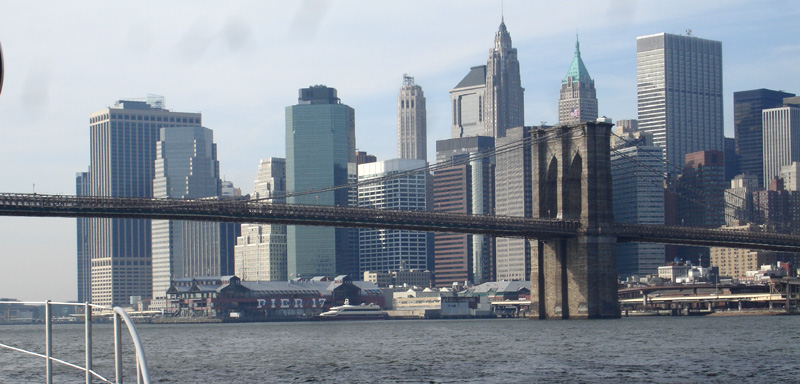
Passing Under the Brooklyn Bridge | |||
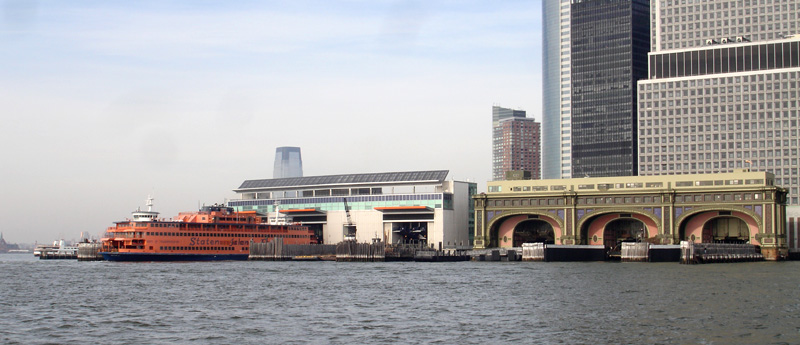
The Manhattan Terminal of the Staten Island Ferry | |||
| The next stage of the trip is the long haul down the New Jersey shore; faster boats can do it in one day, smaller boats can cut inside and run through Barnegat Bay and several small rivers, but we had to do it outside, timing our runs to get to a suitable inlet before it got too dark. This day the weather was good enough -- good-sized seas, but not in a bad direction -- that we decided to continue on to Manasquan Inlet after getting through New York Harbor. There we lay over a day for a little rest and to avoid an easterly blow and then continued on to Atlantic City. By this time, after the bouncing around in Long Island Sound and the run down from New York, we had a lot of faith in the sea-keeping ability of the boat, but still it seemed prudent to avoid serious weather when we could. | |||
| Our version of Atlantic City didn't have much to do with the city as seen by the hordes of gamblers who throng the casino hotels (Trump, Harrods, etc) but as usual concentrated on the waterborne side. We found a nice berth in a city-owned marina next to the aquarium, across from the Coast Guard Base, and in a basin otherwise full of fishing boats. It seemed that we were in an every-other-day pattern with the weather, so we stayed an extra day here too, working on the boat and watching the activity around the huge clam dredgers. |
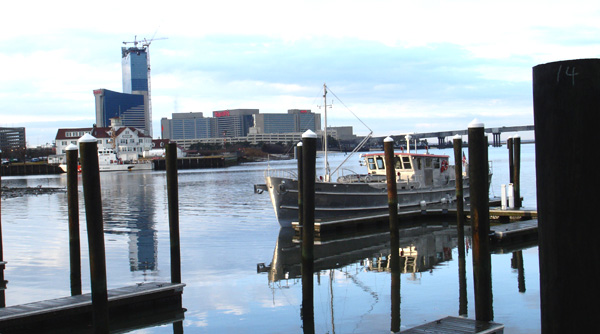
Barbara in Atlantic City | ||
| These are large vessels that tow an apparently very heavy "sled" and large suction hoses to dig the clams out of the bottom and bring them to the surface. In size and complexity they are very impressive. |
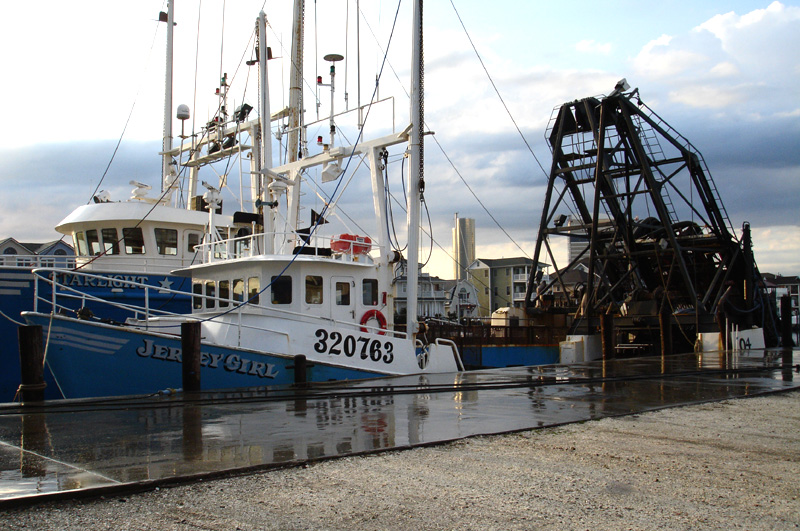
Jersey Girl and Starlight |
||
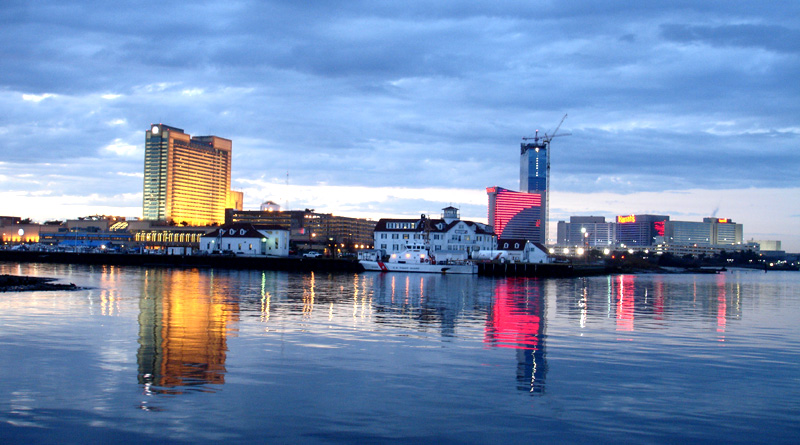
The View of a few Atlantic City Casinos at Dusk from Our Berth | |||
|
We left Atlantic City early on a beautiful day with the wind off the land and for the first time saw a few recreational fishing boats
out and around. We made good time down to Cape May, and in keeping with our "get-the-boat-South" delivery mentality, drove right on through
the Cape May Canal to Delaware Bay, which was increasingly choppy as a north wind freshened. Against the wind and the tide we were not going
to make it to a reasonable anchorage before dark and we were a little tired, so we diverted to the Maurice ("Morris") River and
found a very pleasant anchorage just inside the mouth of the river. Just after we anchored a waterman came by on his way in from the
oyster grounds and cleaning up his boat. He stopped to ask if we were all right, which we found touching and which showed us once again
the brotherhood of people on the water, especially in the winter, when everything is harder.
| |||

| |||
| There was (as usual) a lot of traffic in the ship channel of the Delaware River. I had not been up the river since bringing
American Promise to Annapolis in the 80s, and the traffic, even then considerable, has greatly increased.
Tows like the one above and big ships were going in both directions, and we did our best to stay out of their way. Eventually, we proceeded through the Chesapeake and Delaware Canal and (after an overnight at Chesapeake City, in the middle of the canal) arrived at Baltimore, where we spent a happy week with my brother and his family. |
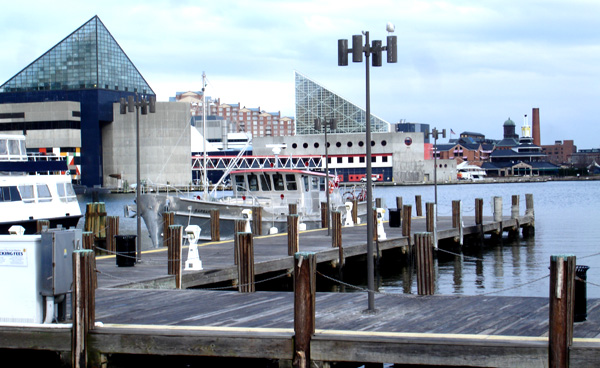
Barbara at the Baltimore City Docks | ||
|
Baltimore is one of a very few major American cities where one can go by boat to the very heart of the city.
Even in New York boats are relegated to the fringes, but the Baltimore City Docks are right in the heart of
downtown.
| |||
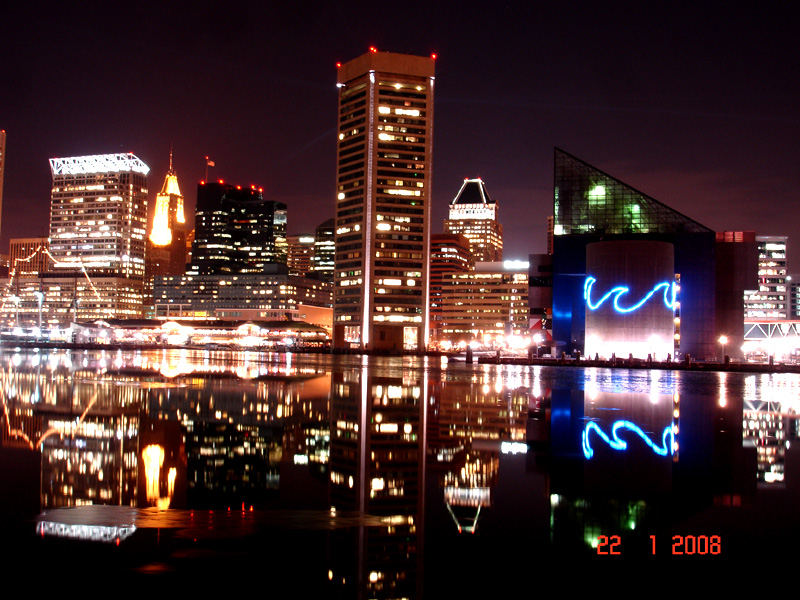 Baltimore City Lights Baltimore City Lights
| |||
|
| |||
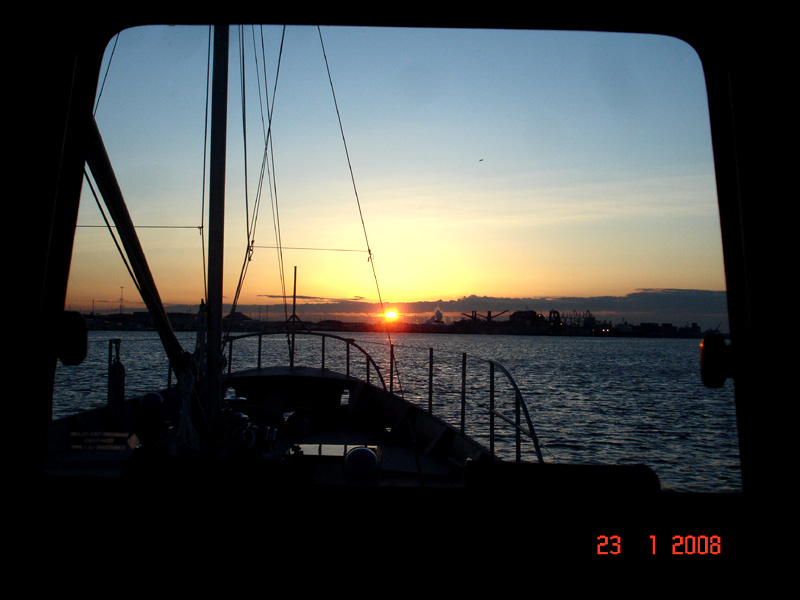
Leaving Baltimore at First Light | |||
|
From Baltimore we went down the Chesapeake on a fair but choppy day to the yachting center of Solomons, in the Patuxent River. The
shores were lined with marinas and boatyards, but there was not much activity on the water. We anchored in a protected cove and
went on early the next morning, without any clear plan as to how far we would get.
As the day went on the wind steadily increased until we had a north wind 0f 25-30 kt with a steep chop. This would be OK until we had to turn west to find a harbor, so we decided to run for Deltaville, just south of the Rappahannock River. Almost by chance, we chose the less crowded southern approach, Jackson Creek in the Piankatank River, and we were very glad, as it turned out. We managed to pick up a ball of old rope (potwarp) in our wheel as we negotiated the shallow entrance channel, and at first were concerned that it might be something more serious. The next day we went ashore to discuss our problem with the people at the Deltaville Boatyard, and they promised us a quick haulout "as soon as the guys get back from lunch." | |||
| They were true to their word and by 1:15 we were in the slings and yard workers were helping us cut the rope clear. We concluded jointly that the cutless bearing was a little worn on the end but otherwise OK, and while we waited for a new shaft zinc the yard owner gave Barbara's hull a quick pressure wash. We stayed another day and left reluctantly, thinking that Deltaville was a place we could settle for a couple of months, if it were only a little warmer (our heater was giving a little trouble and not putting out as much heat as it had previously, despite our efforts to clean it). So we left, reluctantly, as I say, and headed south toward Norfolk and (we hoped) warmer weather. |
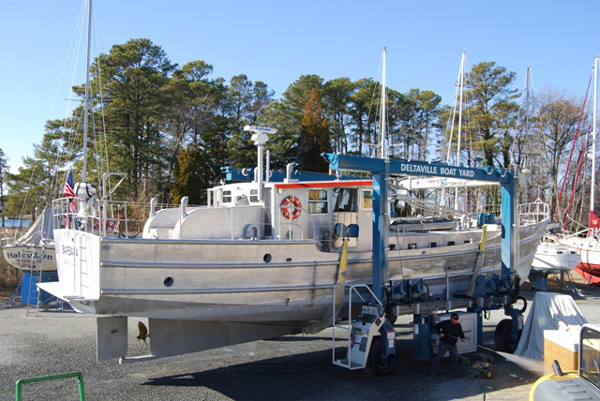
In the Slings at the Deltaville Boatyard Photo: Jennifer Holloway | ||
| There were many interesting boats at the Deltaville Boatyard; several of them were foreign but here are two local examples. | |||
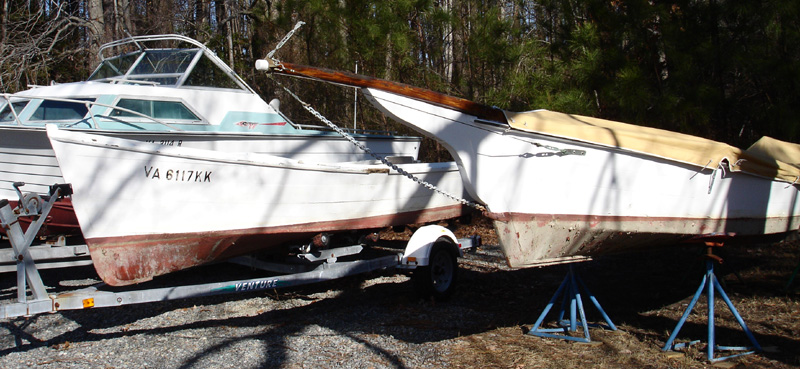
"Deadrise" Skiffs of the Type Once Built Here in Large Numbers | |||
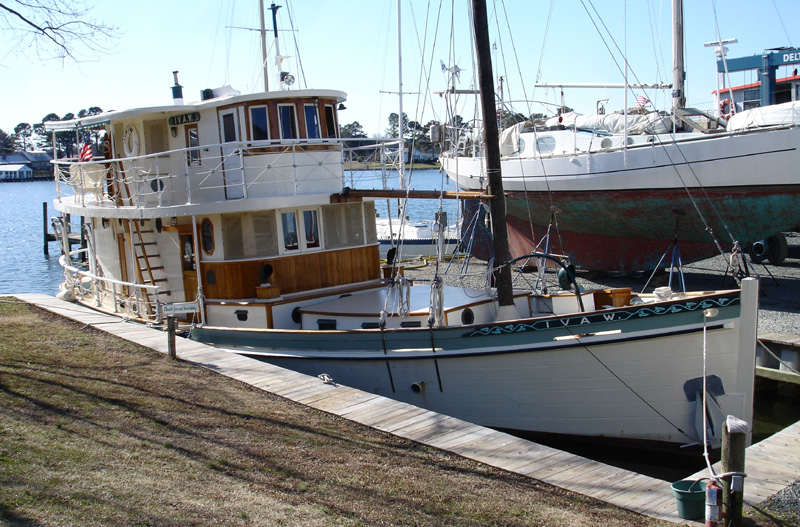 The Iva W is a Type I Associate With the Shallow Sounds
The Iva W is a Type I Associate With the Shallow Sounds
| |||